International Market Evaluation
VerifiedAdded on 2023/01/06
|16
|4820
|93
AI Summary
This document provides an overview of international market evaluation, including global market overview, analysis of international business and electronic commerce market, and the impact of the global financial crisis on world trade. It also discusses different strategies for entering the global market.
Contribute Materials
Your contribution can guide someone’s learning journey. Share your
documents today.
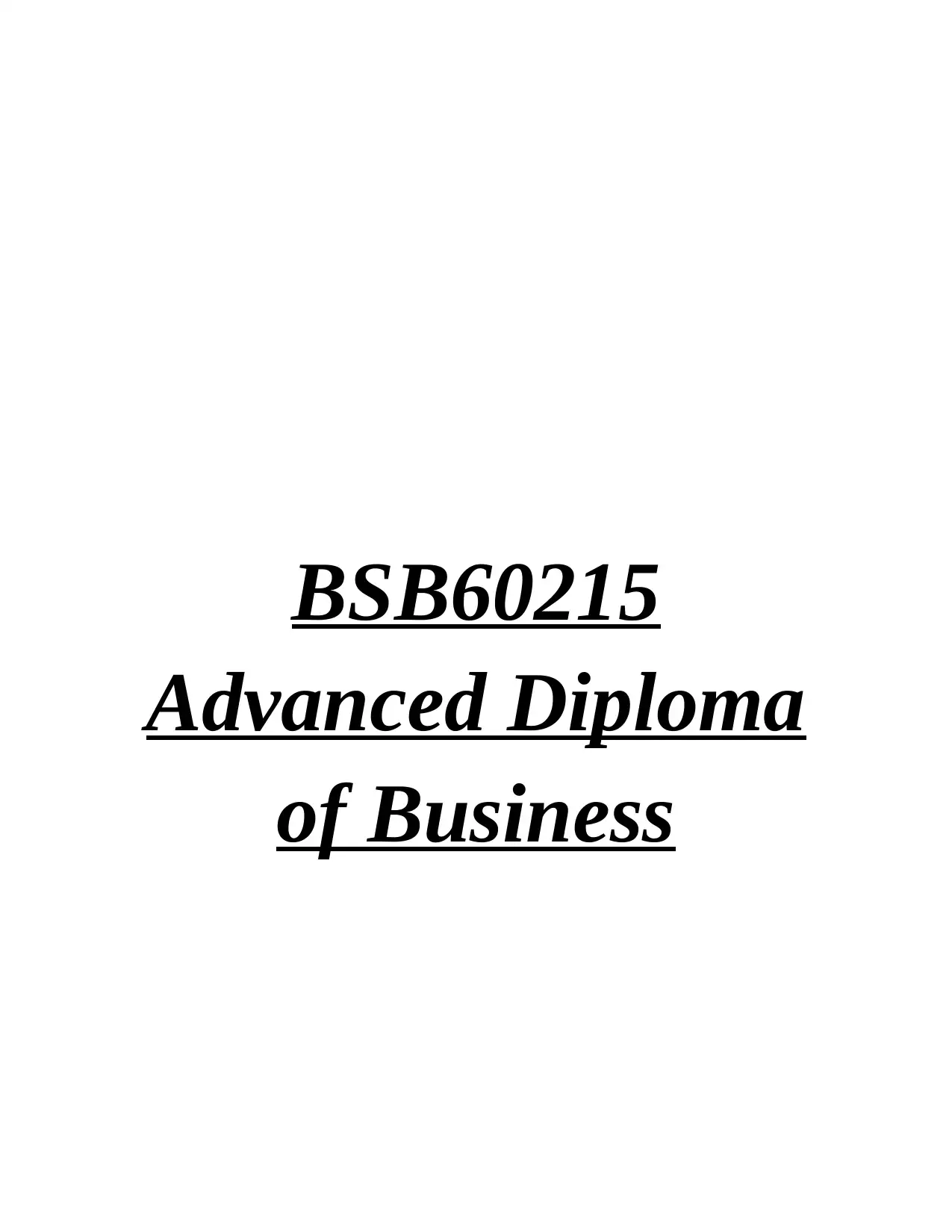
BSB60215
Advanced Diploma
of Business
Advanced Diploma
of Business
Secure Best Marks with AI Grader
Need help grading? Try our AI Grader for instant feedback on your assignments.
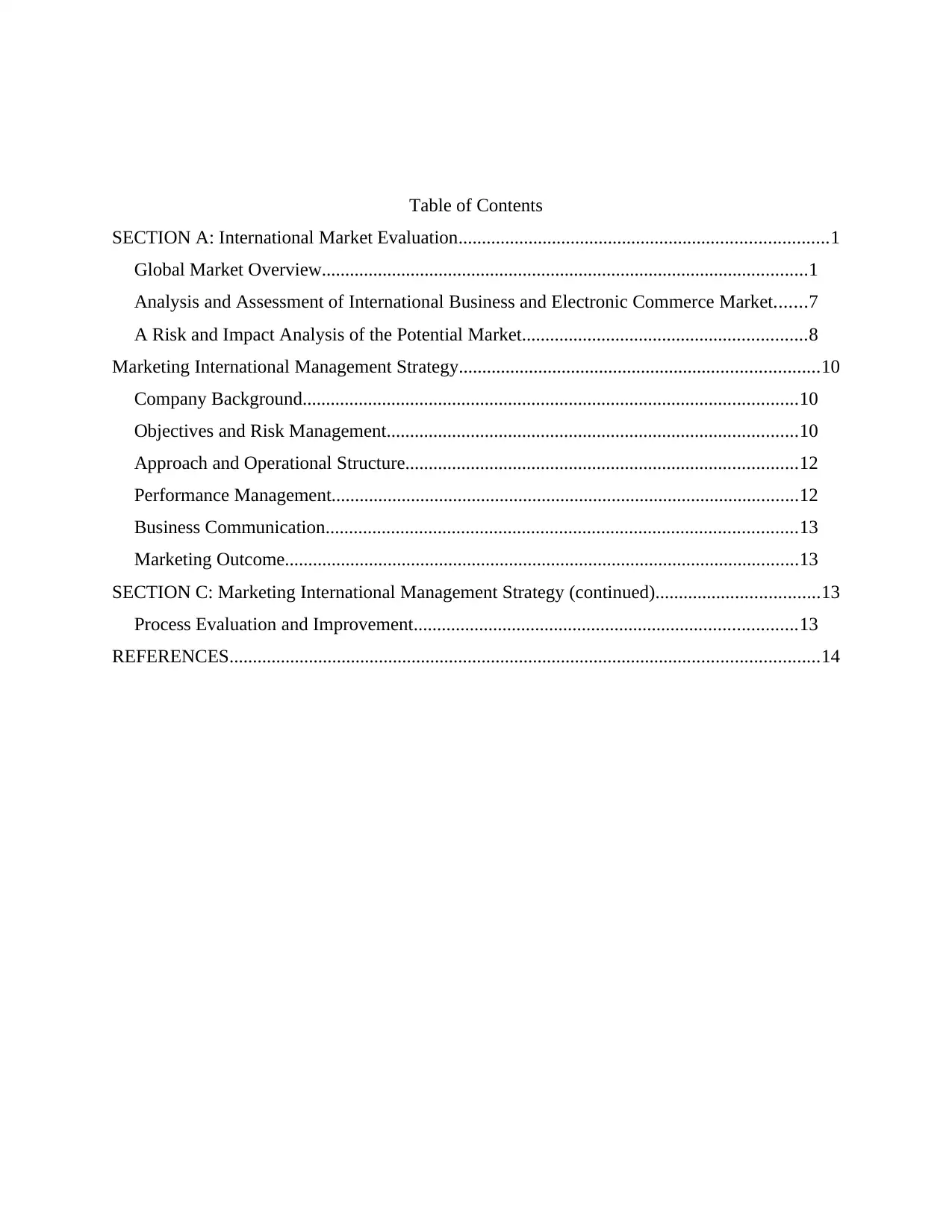
Table of Contents
SECTION A: International Market Evaluation...............................................................................1
Global Market Overview........................................................................................................1
Analysis and Assessment of International Business and Electronic Commerce Market.......7
A Risk and Impact Analysis of the Potential Market.............................................................8
Marketing International Management Strategy.............................................................................10
Company Background..........................................................................................................10
Objectives and Risk Management........................................................................................10
Approach and Operational Structure....................................................................................12
Performance Management....................................................................................................12
Business Communication.....................................................................................................13
Marketing Outcome..............................................................................................................13
SECTION C: Marketing International Management Strategy (continued)...................................13
Process Evaluation and Improvement..................................................................................13
REFERENCES..............................................................................................................................14
SECTION A: International Market Evaluation...............................................................................1
Global Market Overview........................................................................................................1
Analysis and Assessment of International Business and Electronic Commerce Market.......7
A Risk and Impact Analysis of the Potential Market.............................................................8
Marketing International Management Strategy.............................................................................10
Company Background..........................................................................................................10
Objectives and Risk Management........................................................................................10
Approach and Operational Structure....................................................................................12
Performance Management....................................................................................................12
Business Communication.....................................................................................................13
Marketing Outcome..............................................................................................................13
SECTION C: Marketing International Management Strategy (continued)...................................13
Process Evaluation and Improvement..................................................................................13
REFERENCES..............................................................................................................................14
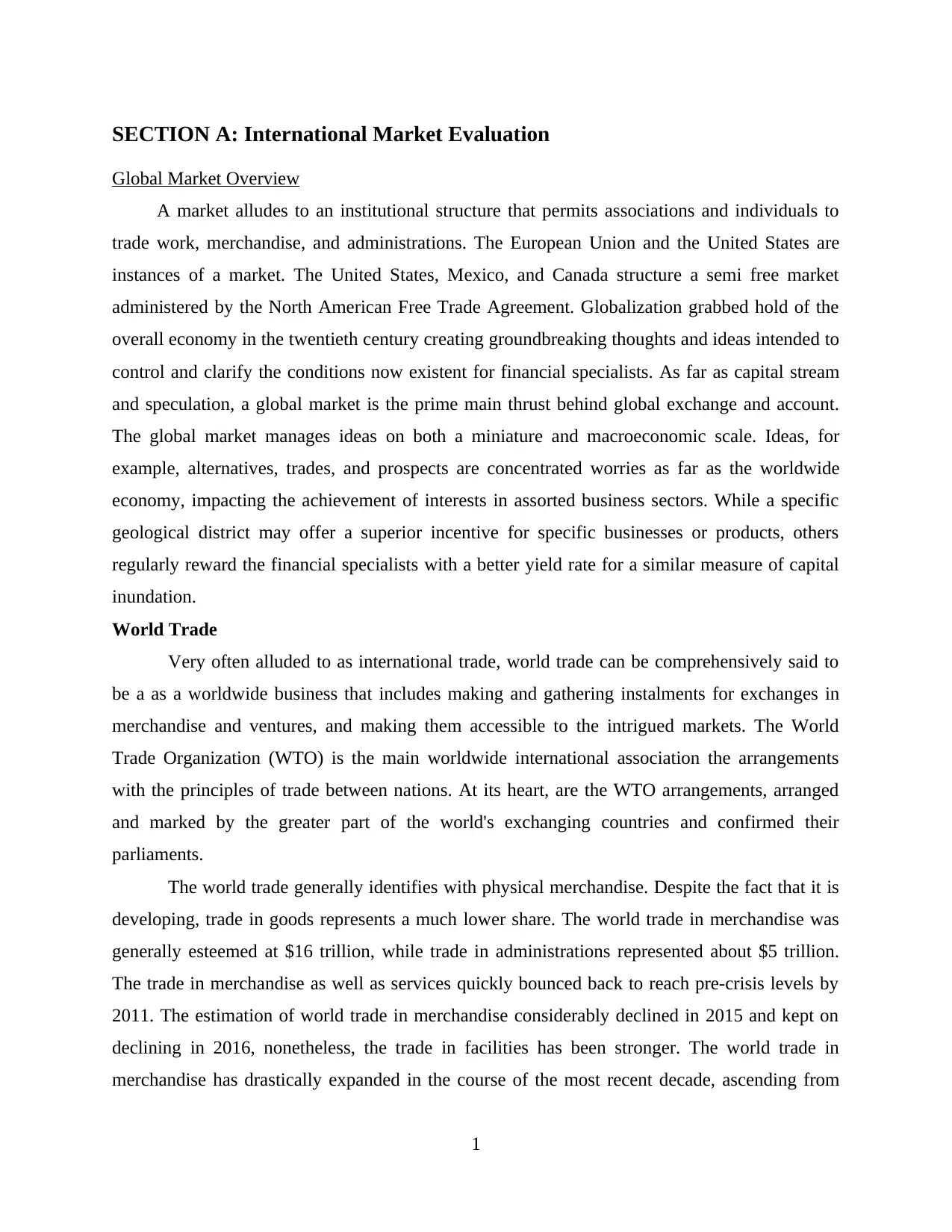
SECTION A: International Market Evaluation
Global Market Overview
A market alludes to an institutional structure that permits associations and individuals to
trade work, merchandise, and administrations. The European Union and the United States are
instances of a market. The United States, Mexico, and Canada structure a semi free market
administered by the North American Free Trade Agreement. Globalization grabbed hold of the
overall economy in the twentieth century creating groundbreaking thoughts and ideas intended to
control and clarify the conditions now existent for financial specialists. As far as capital stream
and speculation, a global market is the prime main thrust behind global exchange and account.
The global market manages ideas on both a miniature and macroeconomic scale. Ideas, for
example, alternatives, trades, and prospects are concentrated worries as far as the worldwide
economy, impacting the achievement of interests in assorted business sectors. While a specific
geological district may offer a superior incentive for specific businesses or products, others
regularly reward the financial specialists with a better yield rate for a similar measure of capital
inundation.
World Trade
Very often alluded to as international trade, world trade can be comprehensively said to
be a as a worldwide business that includes making and gathering instalments for exchanges in
merchandise and ventures, and making them accessible to the intrigued markets. The World
Trade Organization (WTO) is the main worldwide international association the arrangements
with the principles of trade between nations. At its heart, are the WTO arrangements, arranged
and marked by the greater part of the world's exchanging countries and confirmed their
parliaments.
The world trade generally identifies with physical merchandise. Despite the fact that it is
developing, trade in goods represents a much lower share. The world trade in merchandise was
generally esteemed at $16 trillion, while trade in administrations represented about $5 trillion.
The trade in merchandise as well as services quickly bounced back to reach pre-crisis levels by
2011. The estimation of world trade in merchandise considerably declined in 2015 and kept on
declining in 2016, nonetheless, the trade in facilities has been stronger. The world trade in
merchandise has drastically expanded in the course of the most recent decade, ascending from
1
Global Market Overview
A market alludes to an institutional structure that permits associations and individuals to
trade work, merchandise, and administrations. The European Union and the United States are
instances of a market. The United States, Mexico, and Canada structure a semi free market
administered by the North American Free Trade Agreement. Globalization grabbed hold of the
overall economy in the twentieth century creating groundbreaking thoughts and ideas intended to
control and clarify the conditions now existent for financial specialists. As far as capital stream
and speculation, a global market is the prime main thrust behind global exchange and account.
The global market manages ideas on both a miniature and macroeconomic scale. Ideas, for
example, alternatives, trades, and prospects are concentrated worries as far as the worldwide
economy, impacting the achievement of interests in assorted business sectors. While a specific
geological district may offer a superior incentive for specific businesses or products, others
regularly reward the financial specialists with a better yield rate for a similar measure of capital
inundation.
World Trade
Very often alluded to as international trade, world trade can be comprehensively said to
be a as a worldwide business that includes making and gathering instalments for exchanges in
merchandise and ventures, and making them accessible to the intrigued markets. The World
Trade Organization (WTO) is the main worldwide international association the arrangements
with the principles of trade between nations. At its heart, are the WTO arrangements, arranged
and marked by the greater part of the world's exchanging countries and confirmed their
parliaments.
The world trade generally identifies with physical merchandise. Despite the fact that it is
developing, trade in goods represents a much lower share. The world trade in merchandise was
generally esteemed at $16 trillion, while trade in administrations represented about $5 trillion.
The trade in merchandise as well as services quickly bounced back to reach pre-crisis levels by
2011. The estimation of world trade in merchandise considerably declined in 2015 and kept on
declining in 2016, nonetheless, the trade in facilities has been stronger. The world trade in
merchandise has drastically expanded in the course of the most recent decade, ascending from
1
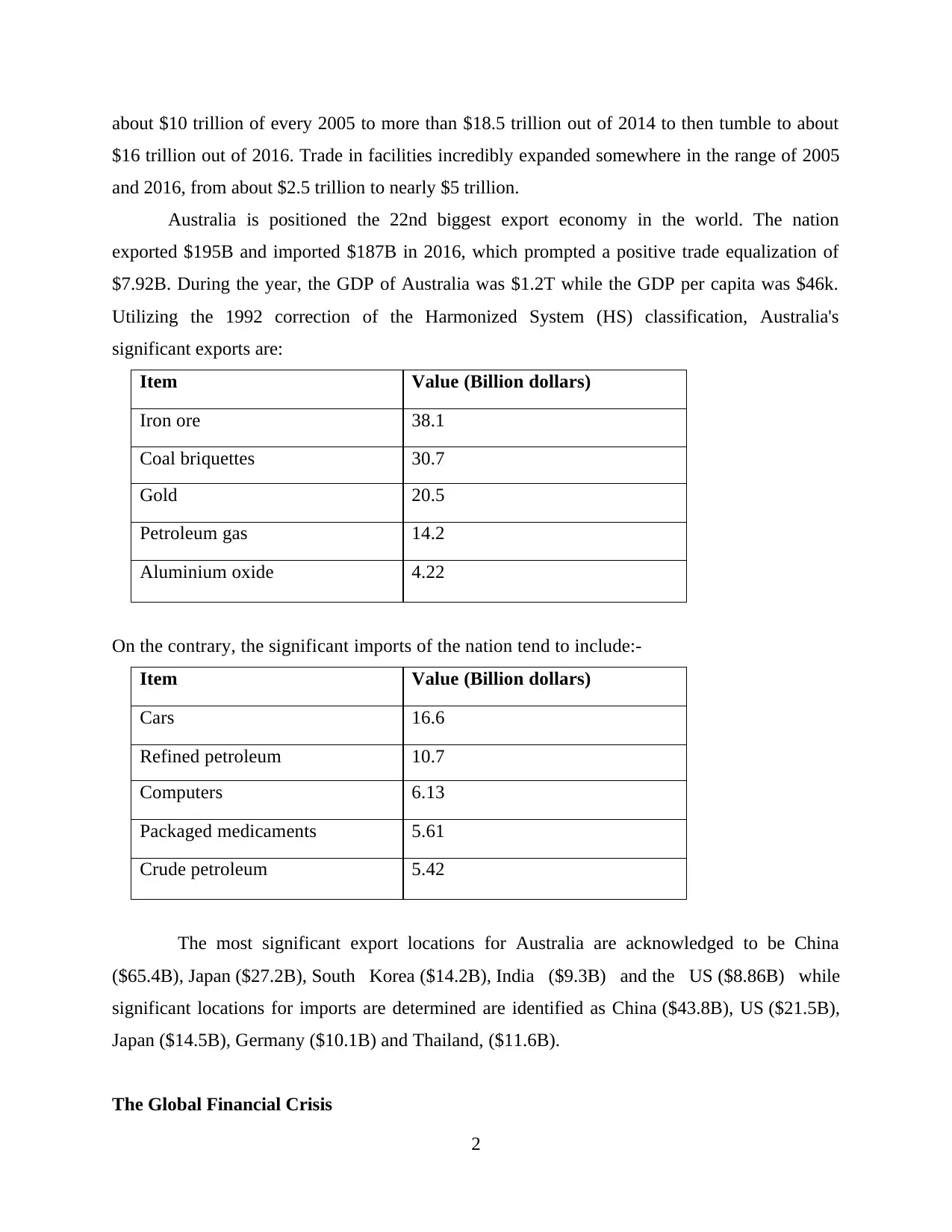
about $10 trillion of every 2005 to more than $18.5 trillion out of 2014 to then tumble to about
$16 trillion out of 2016. Trade in facilities incredibly expanded somewhere in the range of 2005
and 2016, from about $2.5 trillion to nearly $5 trillion.
Australia is positioned the 22nd biggest export economy in the world. The nation
exported $195B and imported $187B in 2016, which prompted a positive trade equalization of
$7.92B. During the year, the GDP of Australia was $1.2T while the GDP per capita was $46k.
Utilizing the 1992 correction of the Harmonized System (HS) classification, Australia's
significant exports are:
Item Value (Billion dollars)
Iron ore 38.1
Coal briquettes 30.7
Gold 20.5
Petroleum gas 14.2
Aluminium oxide 4.22
On the contrary, the significant imports of the nation tend to include:-
Item Value (Billion dollars)
Cars 16.6
Refined petroleum 10.7
Computers 6.13
Packaged medicaments 5.61
Crude petroleum 5.42
The most significant export locations for Australia are acknowledged to be China
($65.4B), Japan ($27.2B), South Korea ($14.2B), India ($9.3B) and the US ($8.86B) while
significant locations for imports are determined are identified as China ($43.8B), US ($21.5B),
Japan ($14.5B), Germany ($10.1B) and Thailand, ($11.6B).
The Global Financial Crisis
2
$16 trillion out of 2016. Trade in facilities incredibly expanded somewhere in the range of 2005
and 2016, from about $2.5 trillion to nearly $5 trillion.
Australia is positioned the 22nd biggest export economy in the world. The nation
exported $195B and imported $187B in 2016, which prompted a positive trade equalization of
$7.92B. During the year, the GDP of Australia was $1.2T while the GDP per capita was $46k.
Utilizing the 1992 correction of the Harmonized System (HS) classification, Australia's
significant exports are:
Item Value (Billion dollars)
Iron ore 38.1
Coal briquettes 30.7
Gold 20.5
Petroleum gas 14.2
Aluminium oxide 4.22
On the contrary, the significant imports of the nation tend to include:-
Item Value (Billion dollars)
Cars 16.6
Refined petroleum 10.7
Computers 6.13
Packaged medicaments 5.61
Crude petroleum 5.42
The most significant export locations for Australia are acknowledged to be China
($65.4B), Japan ($27.2B), South Korea ($14.2B), India ($9.3B) and the US ($8.86B) while
significant locations for imports are determined are identified as China ($43.8B), US ($21.5B),
Japan ($14.5B), Germany ($10.1B) and Thailand, ($11.6B).
The Global Financial Crisis
2
Secure Best Marks with AI Grader
Need help grading? Try our AI Grader for instant feedback on your assignments.
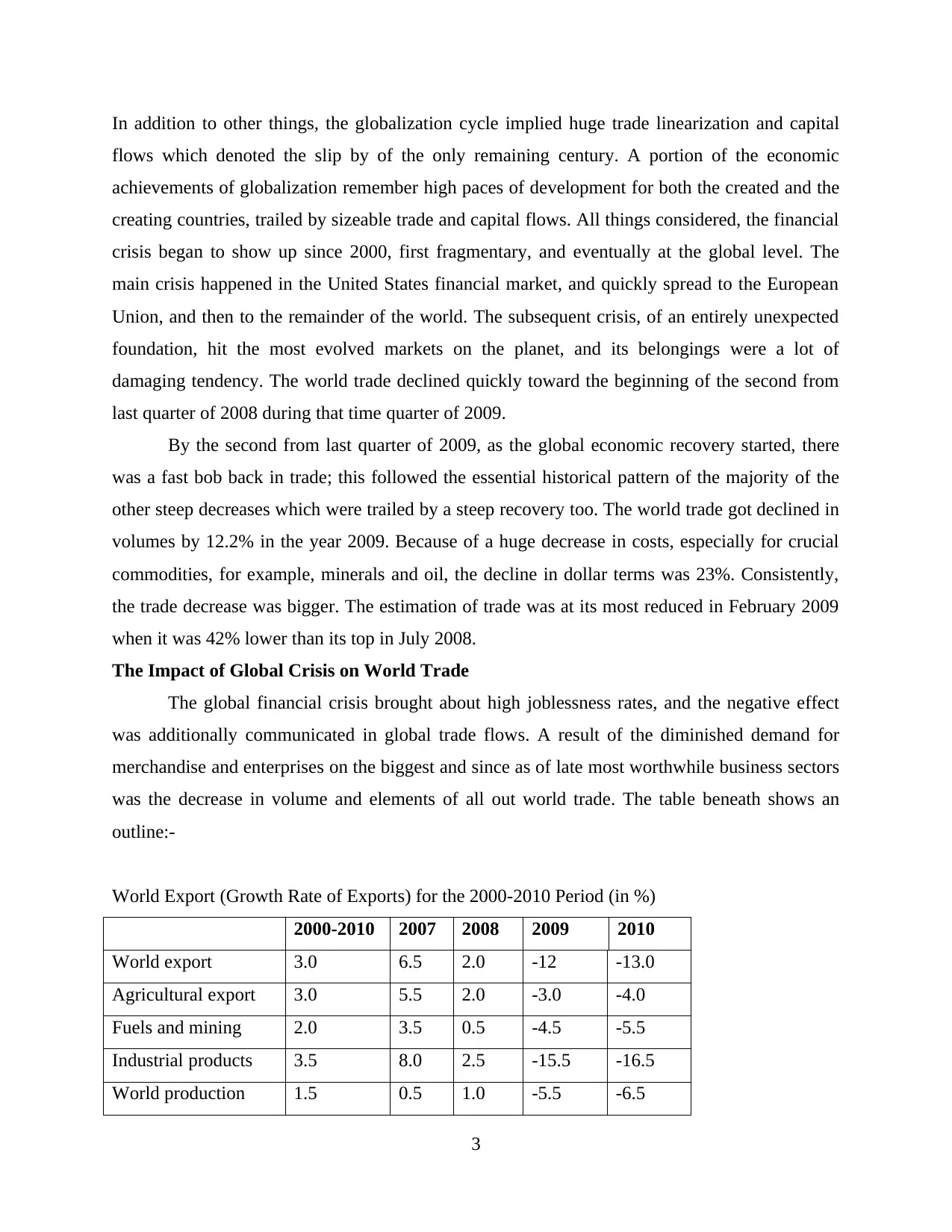
In addition to other things, the globalization cycle implied huge trade linearization and capital
flows which denoted the slip by of the only remaining century. A portion of the economic
achievements of globalization remember high paces of development for both the created and the
creating countries, trailed by sizeable trade and capital flows. All things considered, the financial
crisis began to show up since 2000, first fragmentary, and eventually at the global level. The
main crisis happened in the United States financial market, and quickly spread to the European
Union, and then to the remainder of the world. The subsequent crisis, of an entirely unexpected
foundation, hit the most evolved markets on the planet, and its belongings were a lot of
damaging tendency. The world trade declined quickly toward the beginning of the second from
last quarter of 2008 during that time quarter of 2009.
By the second from last quarter of 2009, as the global economic recovery started, there
was a fast bob back in trade; this followed the essential historical pattern of the majority of the
other steep decreases which were trailed by a steep recovery too. The world trade got declined in
volumes by 12.2% in the year 2009. Because of a huge decrease in costs, especially for crucial
commodities, for example, minerals and oil, the decline in dollar terms was 23%. Consistently,
the trade decrease was bigger. The estimation of trade was at its most reduced in February 2009
when it was 42% lower than its top in July 2008.
The Impact of Global Crisis on World Trade
The global financial crisis brought about high joblessness rates, and the negative effect
was additionally communicated in global trade flows. A result of the diminished demand for
merchandise and enterprises on the biggest and since as of late most worthwhile business sectors
was the decrease in volume and elements of all out world trade. The table beneath shows an
outline:-
World Export (Growth Rate of Exports) for the 2000-2010 Period (in %)
2000-2010 2007 2008 2009 2010
World export 3.0 6.5 2.0 -12 -13.0
Agricultural export 3.0 5.5 2.0 -3.0 -4.0
Fuels and mining 2.0 3.5 0.5 -4.5 -5.5
Industrial products 3.5 8.0 2.5 -15.5 -16.5
World production 1.5 0.5 1.0 -5.5 -6.5
3
flows which denoted the slip by of the only remaining century. A portion of the economic
achievements of globalization remember high paces of development for both the created and the
creating countries, trailed by sizeable trade and capital flows. All things considered, the financial
crisis began to show up since 2000, first fragmentary, and eventually at the global level. The
main crisis happened in the United States financial market, and quickly spread to the European
Union, and then to the remainder of the world. The subsequent crisis, of an entirely unexpected
foundation, hit the most evolved markets on the planet, and its belongings were a lot of
damaging tendency. The world trade declined quickly toward the beginning of the second from
last quarter of 2008 during that time quarter of 2009.
By the second from last quarter of 2009, as the global economic recovery started, there
was a fast bob back in trade; this followed the essential historical pattern of the majority of the
other steep decreases which were trailed by a steep recovery too. The world trade got declined in
volumes by 12.2% in the year 2009. Because of a huge decrease in costs, especially for crucial
commodities, for example, minerals and oil, the decline in dollar terms was 23%. Consistently,
the trade decrease was bigger. The estimation of trade was at its most reduced in February 2009
when it was 42% lower than its top in July 2008.
The Impact of Global Crisis on World Trade
The global financial crisis brought about high joblessness rates, and the negative effect
was additionally communicated in global trade flows. A result of the diminished demand for
merchandise and enterprises on the biggest and since as of late most worthwhile business sectors
was the decrease in volume and elements of all out world trade. The table beneath shows an
outline:-
World Export (Growth Rate of Exports) for the 2000-2010 Period (in %)
2000-2010 2007 2008 2009 2010
World export 3.0 6.5 2.0 -12 -13.0
Agricultural export 3.0 5.5 2.0 -3.0 -4.0
Fuels and mining 2.0 3.5 0.5 -4.5 -5.5
Industrial products 3.5 8.0 2.5 -15.5 -16.5
World production 1.5 0.5 1.0 -5.5 -6.5
3
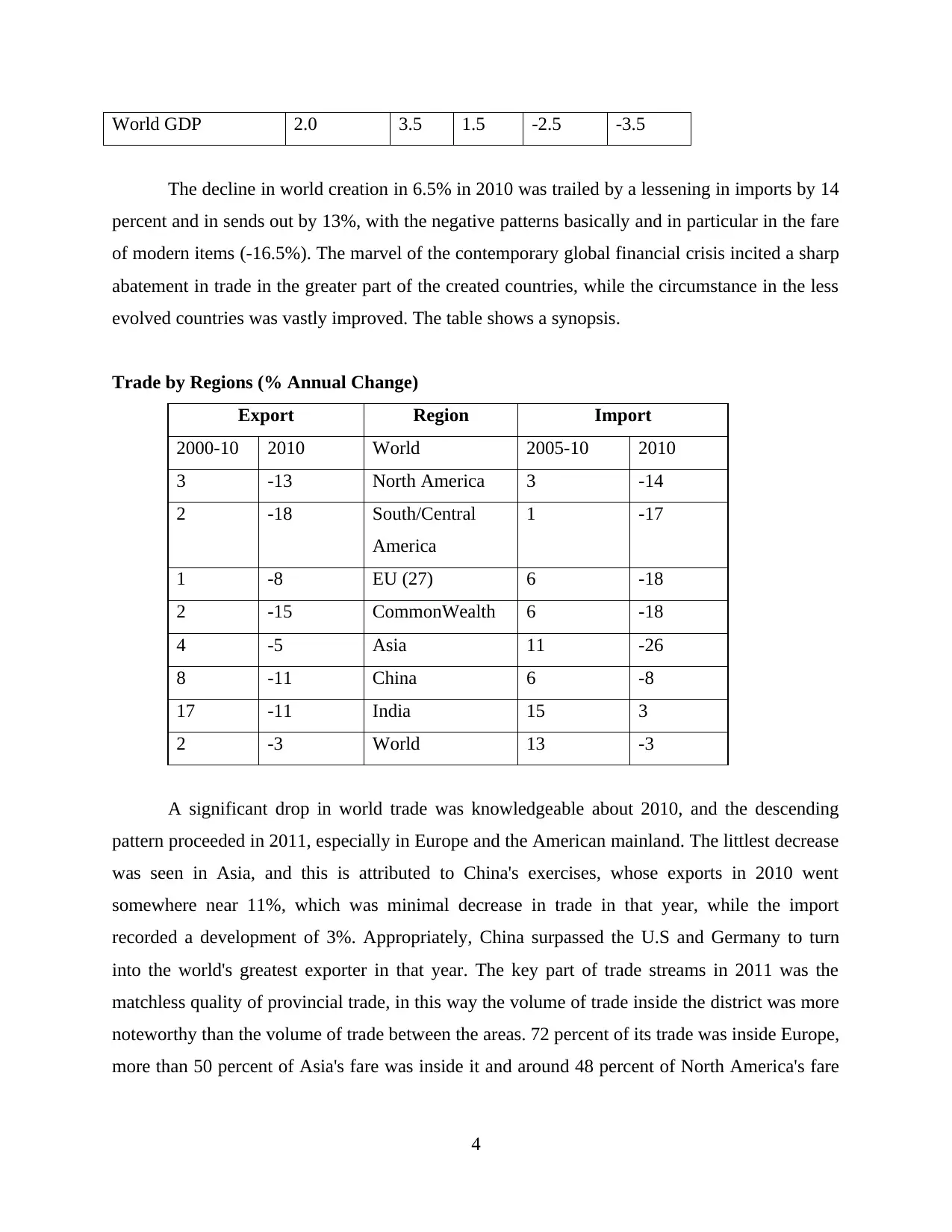
World GDP 2.0 3.5 1.5 -2.5 -3.5
The decline in world creation in 6.5% in 2010 was trailed by a lessening in imports by 14
percent and in sends out by 13%, with the negative patterns basically and in particular in the fare
of modern items (-16.5%). The marvel of the contemporary global financial crisis incited a sharp
abatement in trade in the greater part of the created countries, while the circumstance in the less
evolved countries was vastly improved. The table shows a synopsis.
Trade by Regions (% Annual Change)
Export Region Import
2000-10 2010 World 2005-10 2010
3 -13 North America 3 -14
2 -18 South/Central
America
1 -17
1 -8 EU (27) 6 -18
2 -15 CommonWealth 6 -18
4 -5 Asia 11 -26
8 -11 China 6 -8
17 -11 India 15 3
2 -3 World 13 -3
A significant drop in world trade was knowledgeable about 2010, and the descending
pattern proceeded in 2011, especially in Europe and the American mainland. The littlest decrease
was seen in Asia, and this is attributed to China's exercises, whose exports in 2010 went
somewhere near 11%, which was minimal decrease in trade in that year, while the import
recorded a development of 3%. Appropriately, China surpassed the U.S and Germany to turn
into the world's greatest exporter in that year. The key part of trade streams in 2011 was the
matchless quality of provincial trade, in this way the volume of trade inside the district was more
noteworthy than the volume of trade between the areas. 72 percent of its trade was inside Europe,
more than 50 percent of Asia's fare was inside it and around 48 percent of North America's fare
4
The decline in world creation in 6.5% in 2010 was trailed by a lessening in imports by 14
percent and in sends out by 13%, with the negative patterns basically and in particular in the fare
of modern items (-16.5%). The marvel of the contemporary global financial crisis incited a sharp
abatement in trade in the greater part of the created countries, while the circumstance in the less
evolved countries was vastly improved. The table shows a synopsis.
Trade by Regions (% Annual Change)
Export Region Import
2000-10 2010 World 2005-10 2010
3 -13 North America 3 -14
2 -18 South/Central
America
1 -17
1 -8 EU (27) 6 -18
2 -15 CommonWealth 6 -18
4 -5 Asia 11 -26
8 -11 China 6 -8
17 -11 India 15 3
2 -3 World 13 -3
A significant drop in world trade was knowledgeable about 2010, and the descending
pattern proceeded in 2011, especially in Europe and the American mainland. The littlest decrease
was seen in Asia, and this is attributed to China's exercises, whose exports in 2010 went
somewhere near 11%, which was minimal decrease in trade in that year, while the import
recorded a development of 3%. Appropriately, China surpassed the U.S and Germany to turn
into the world's greatest exporter in that year. The key part of trade streams in 2011 was the
matchless quality of provincial trade, in this way the volume of trade inside the district was more
noteworthy than the volume of trade between the areas. 72 percent of its trade was inside Europe,
more than 50 percent of Asia's fare was inside it and around 48 percent of North America's fare
4
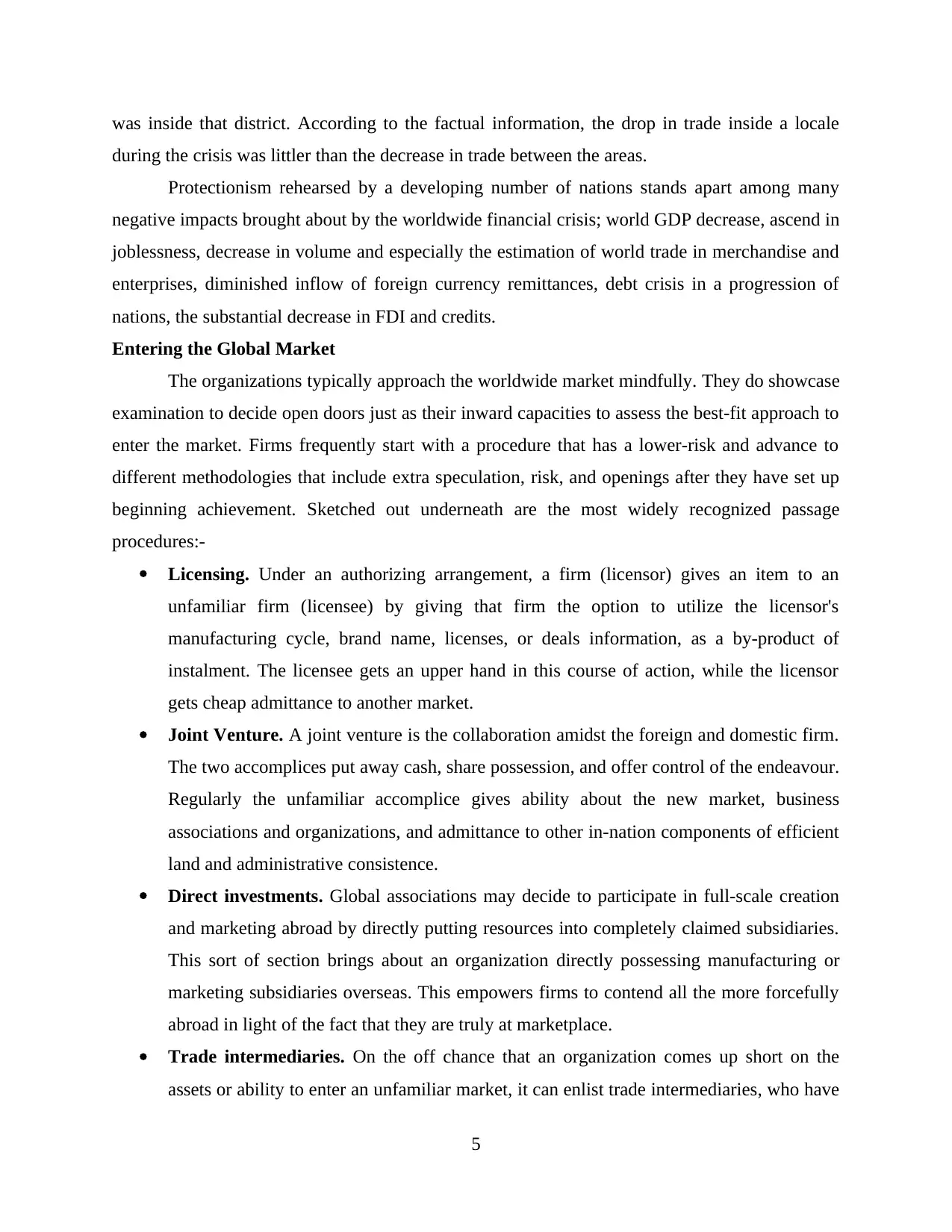
was inside that district. According to the factual information, the drop in trade inside a locale
during the crisis was littler than the decrease in trade between the areas.
Protectionism rehearsed by a developing number of nations stands apart among many
negative impacts brought about by the worldwide financial crisis; world GDP decrease, ascend in
joblessness, decrease in volume and especially the estimation of world trade in merchandise and
enterprises, diminished inflow of foreign currency remittances, debt crisis in a progression of
nations, the substantial decrease in FDI and credits.
Entering the Global Market
The organizations typically approach the worldwide market mindfully. They do showcase
examination to decide open doors just as their inward capacities to assess the best-fit approach to
enter the market. Firms frequently start with a procedure that has a lower-risk and advance to
different methodologies that include extra speculation, risk, and openings after they have set up
beginning achievement. Sketched out underneath are the most widely recognized passage
procedures:-
Licensing. Under an authorizing arrangement, a firm (licensor) gives an item to an
unfamiliar firm (licensee) by giving that firm the option to utilize the licensor's
manufacturing cycle, brand name, licenses, or deals information, as a by-product of
instalment. The licensee gets an upper hand in this course of action, while the licensor
gets cheap admittance to another market.
Joint Venture. A joint venture is the collaboration amidst the foreign and domestic firm.
The two accomplices put away cash, share possession, and offer control of the endeavour.
Regularly the unfamiliar accomplice gives ability about the new market, business
associations and organizations, and admittance to other in-nation components of efficient
land and administrative consistence.
Direct investments. Global associations may decide to participate in full-scale creation
and marketing abroad by directly putting resources into completely claimed subsidiaries.
This sort of section brings about an organization directly possessing manufacturing or
marketing subsidiaries overseas. This empowers firms to contend all the more forcefully
abroad in light of the fact that they are truly at marketplace.
Trade intermediaries. On the off chance that an organization comes up short on the
assets or ability to enter an unfamiliar market, it can enlist trade intermediaries, who have
5
during the crisis was littler than the decrease in trade between the areas.
Protectionism rehearsed by a developing number of nations stands apart among many
negative impacts brought about by the worldwide financial crisis; world GDP decrease, ascend in
joblessness, decrease in volume and especially the estimation of world trade in merchandise and
enterprises, diminished inflow of foreign currency remittances, debt crisis in a progression of
nations, the substantial decrease in FDI and credits.
Entering the Global Market
The organizations typically approach the worldwide market mindfully. They do showcase
examination to decide open doors just as their inward capacities to assess the best-fit approach to
enter the market. Firms frequently start with a procedure that has a lower-risk and advance to
different methodologies that include extra speculation, risk, and openings after they have set up
beginning achievement. Sketched out underneath are the most widely recognized passage
procedures:-
Licensing. Under an authorizing arrangement, a firm (licensor) gives an item to an
unfamiliar firm (licensee) by giving that firm the option to utilize the licensor's
manufacturing cycle, brand name, licenses, or deals information, as a by-product of
instalment. The licensee gets an upper hand in this course of action, while the licensor
gets cheap admittance to another market.
Joint Venture. A joint venture is the collaboration amidst the foreign and domestic firm.
The two accomplices put away cash, share possession, and offer control of the endeavour.
Regularly the unfamiliar accomplice gives ability about the new market, business
associations and organizations, and admittance to other in-nation components of efficient
land and administrative consistence.
Direct investments. Global associations may decide to participate in full-scale creation
and marketing abroad by directly putting resources into completely claimed subsidiaries.
This sort of section brings about an organization directly possessing manufacturing or
marketing subsidiaries overseas. This empowers firms to contend all the more forcefully
abroad in light of the fact that they are truly at marketplace.
Trade intermediaries. On the off chance that an organization comes up short on the
assets or ability to enter an unfamiliar market, it can enlist trade intermediaries, who have
5
Paraphrase This Document
Need a fresh take? Get an instant paraphrase of this document with our AI Paraphraser

the essential the contacts and connections in those business sectors. These entrepreneurial
middlemen commonly buy U.S. delivered merchandise at rates under a maker's best limit
and afterward exchange them in overseas business sectors.
Businesses usually approach the global market cautiously. They carry out market analysis
to determine opportunities as well as their internal capabilities to evaluate the best-fit approach to
enter the market. Firms often start with a strategy that has a lower-risk and advance to other
strategies that involve additional investment, risk, and opportunities after they have established
initial success. Outlined below are the most common entry strategies:-
Licensing- Under a licensing agreement, a firm (licensor) provides a product to a foreign
firm (licensee) by granting that firm the right to use the licensor’s manufacturing process,
brand name, patents, or sales knowledge, in return for payment. The licensee obtains a
competitive advantage in this arrangement, while the licensor obtains inexpensive access
to a new market.
Joint Venture- A joint venture is a partnership between a domestic and foreign firm. Both
partners invest money, share ownership, and share control of the venture. Typically the
foreign partner provides expertise about the new market, business connections and
networks, and access to other in-country elements of business like real-estate and
regulatory compliance.
Direct investments- Multinational organizations may choose to engage in full-scale
production and marketing abroad by directly investing in wholly-owned subsidiaries.
This type of entry results in a company directly owning manufacturing or marketing
subsidiaries overseas. This enables firms to compete more aggressively abroad because
they are literally at market place
Trade intermediaries.If a company lacks the resources or expertise to enter a foreign
market, it can hire trade intermediaries, who possess the necessary the contacts and
relationships in those markets. These entrepreneurial middlemen typically purchase U.S.-
produced goods at a rate below a manufacturer’s best discount and then resell them in
overseas markets.
Free Trade and Protectionism
Protectionism alludes to trade limitation with different countries with a plan of shielding nearby
firms from worldwide rivalry. For example, the U.S Trump organization has shaken the
6
middlemen commonly buy U.S. delivered merchandise at rates under a maker's best limit
and afterward exchange them in overseas business sectors.
Businesses usually approach the global market cautiously. They carry out market analysis
to determine opportunities as well as their internal capabilities to evaluate the best-fit approach to
enter the market. Firms often start with a strategy that has a lower-risk and advance to other
strategies that involve additional investment, risk, and opportunities after they have established
initial success. Outlined below are the most common entry strategies:-
Licensing- Under a licensing agreement, a firm (licensor) provides a product to a foreign
firm (licensee) by granting that firm the right to use the licensor’s manufacturing process,
brand name, patents, or sales knowledge, in return for payment. The licensee obtains a
competitive advantage in this arrangement, while the licensor obtains inexpensive access
to a new market.
Joint Venture- A joint venture is a partnership between a domestic and foreign firm. Both
partners invest money, share ownership, and share control of the venture. Typically the
foreign partner provides expertise about the new market, business connections and
networks, and access to other in-country elements of business like real-estate and
regulatory compliance.
Direct investments- Multinational organizations may choose to engage in full-scale
production and marketing abroad by directly investing in wholly-owned subsidiaries.
This type of entry results in a company directly owning manufacturing or marketing
subsidiaries overseas. This enables firms to compete more aggressively abroad because
they are literally at market place
Trade intermediaries.If a company lacks the resources or expertise to enter a foreign
market, it can hire trade intermediaries, who possess the necessary the contacts and
relationships in those markets. These entrepreneurial middlemen typically purchase U.S.-
produced goods at a rate below a manufacturer’s best discount and then resell them in
overseas markets.
Free Trade and Protectionism
Protectionism alludes to trade limitation with different countries with a plan of shielding nearby
firms from worldwide rivalry. For example, the U.S Trump organization has shaken the
6
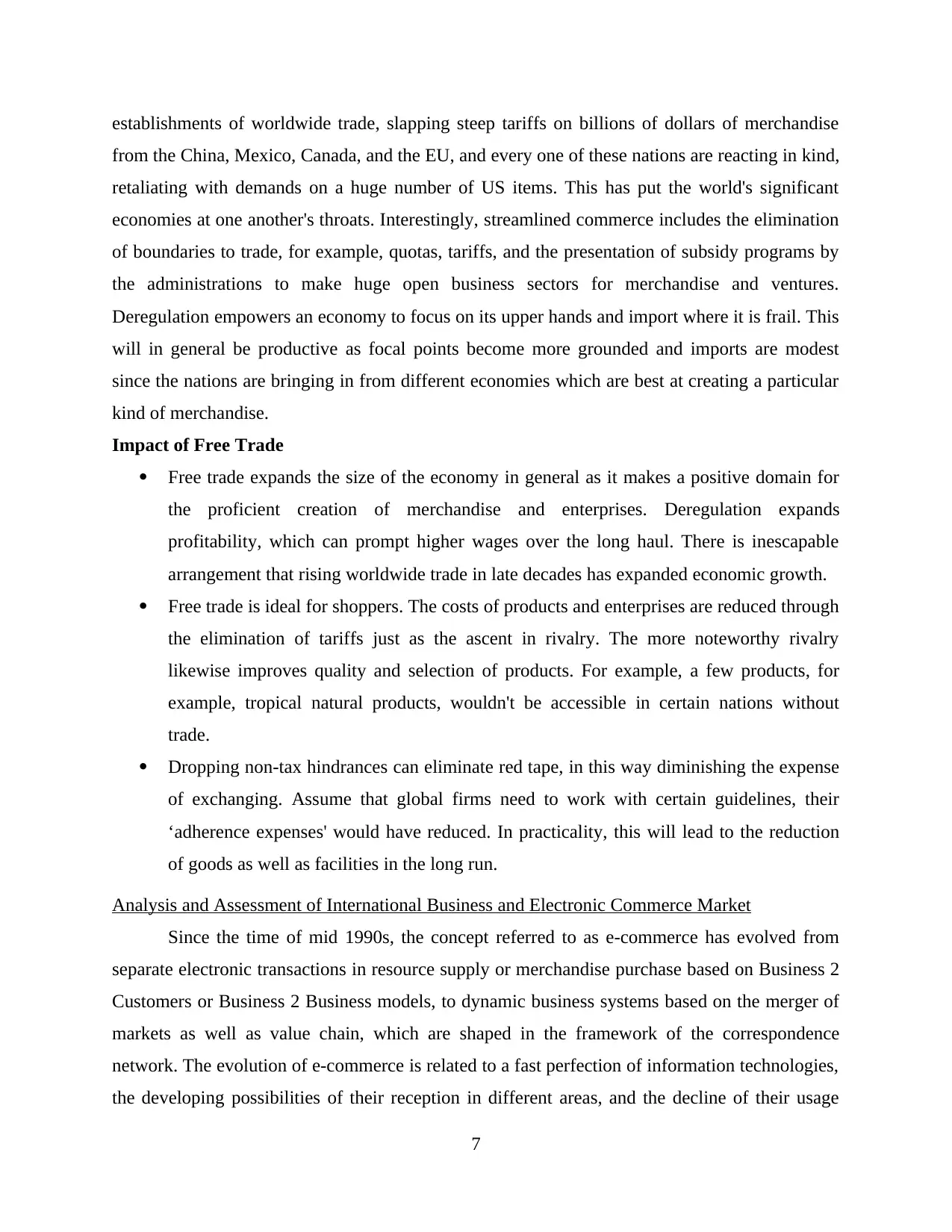
establishments of worldwide trade, slapping steep tariffs on billions of dollars of merchandise
from the China, Mexico, Canada, and the EU, and every one of these nations are reacting in kind,
retaliating with demands on a huge number of US items. This has put the world's significant
economies at one another's throats. Interestingly, streamlined commerce includes the elimination
of boundaries to trade, for example, quotas, tariffs, and the presentation of subsidy programs by
the administrations to make huge open business sectors for merchandise and ventures.
Deregulation empowers an economy to focus on its upper hands and import where it is frail. This
will in general be productive as focal points become more grounded and imports are modest
since the nations are bringing in from different economies which are best at creating a particular
kind of merchandise.
Impact of Free Trade
Free trade expands the size of the economy in general as it makes a positive domain for
the proficient creation of merchandise and enterprises. Deregulation expands
profitability, which can prompt higher wages over the long haul. There is inescapable
arrangement that rising worldwide trade in late decades has expanded economic growth.
Free trade is ideal for shoppers. The costs of products and enterprises are reduced through
the elimination of tariffs just as the ascent in rivalry. The more noteworthy rivalry
likewise improves quality and selection of products. For example, a few products, for
example, tropical natural products, wouldn't be accessible in certain nations without
trade.
Dropping non-tax hindrances can eliminate red tape, in this way diminishing the expense
of exchanging. Assume that global firms need to work with certain guidelines, their
‘adherence expenses' would have reduced. In practicality, this will lead to the reduction
of goods as well as facilities in the long run.
Analysis and Assessment of International Business and Electronic Commerce Market
Since the time of mid 1990s, the concept referred to as e-commerce has evolved from
separate electronic transactions in resource supply or merchandise purchase based on Business 2
Customers or Business 2 Business models, to dynamic business systems based on the merger of
markets as well as value chain, which are shaped in the framework of the correspondence
network. The evolution of e-commerce is related to a fast perfection of information technologies,
the developing possibilities of their reception in different areas, and the decline of their usage
7
from the China, Mexico, Canada, and the EU, and every one of these nations are reacting in kind,
retaliating with demands on a huge number of US items. This has put the world's significant
economies at one another's throats. Interestingly, streamlined commerce includes the elimination
of boundaries to trade, for example, quotas, tariffs, and the presentation of subsidy programs by
the administrations to make huge open business sectors for merchandise and ventures.
Deregulation empowers an economy to focus on its upper hands and import where it is frail. This
will in general be productive as focal points become more grounded and imports are modest
since the nations are bringing in from different economies which are best at creating a particular
kind of merchandise.
Impact of Free Trade
Free trade expands the size of the economy in general as it makes a positive domain for
the proficient creation of merchandise and enterprises. Deregulation expands
profitability, which can prompt higher wages over the long haul. There is inescapable
arrangement that rising worldwide trade in late decades has expanded economic growth.
Free trade is ideal for shoppers. The costs of products and enterprises are reduced through
the elimination of tariffs just as the ascent in rivalry. The more noteworthy rivalry
likewise improves quality and selection of products. For example, a few products, for
example, tropical natural products, wouldn't be accessible in certain nations without
trade.
Dropping non-tax hindrances can eliminate red tape, in this way diminishing the expense
of exchanging. Assume that global firms need to work with certain guidelines, their
‘adherence expenses' would have reduced. In practicality, this will lead to the reduction
of goods as well as facilities in the long run.
Analysis and Assessment of International Business and Electronic Commerce Market
Since the time of mid 1990s, the concept referred to as e-commerce has evolved from
separate electronic transactions in resource supply or merchandise purchase based on Business 2
Customers or Business 2 Business models, to dynamic business systems based on the merger of
markets as well as value chain, which are shaped in the framework of the correspondence
network. The evolution of e-commerce is related to a fast perfection of information technologies,
the developing possibilities of their reception in different areas, and the decline of their usage
7
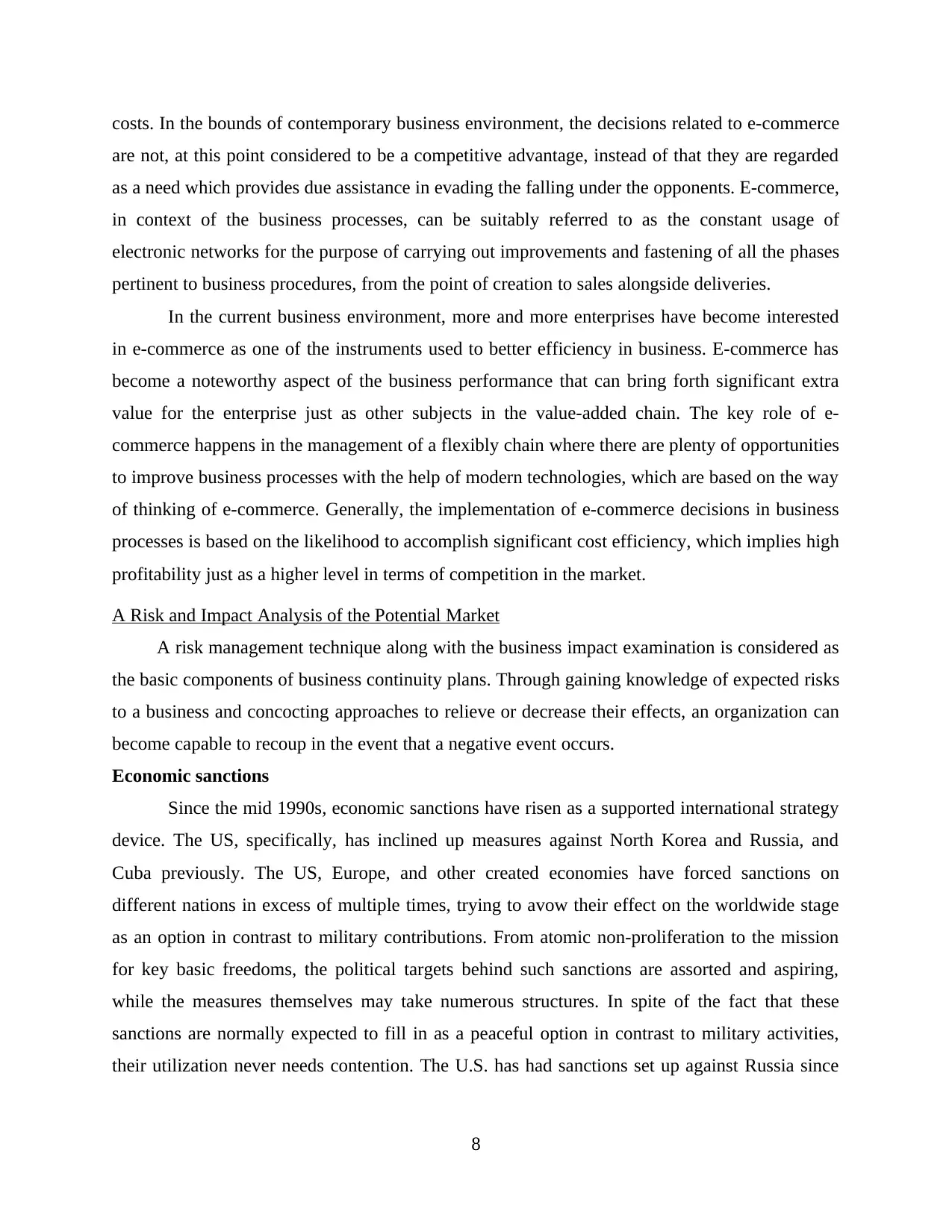
costs. In the bounds of contemporary business environment, the decisions related to e-commerce
are not, at this point considered to be a competitive advantage, instead of that they are regarded
as a need which provides due assistance in evading the falling under the opponents. E-commerce,
in context of the business processes, can be suitably referred to as the constant usage of
electronic networks for the purpose of carrying out improvements and fastening of all the phases
pertinent to business procedures, from the point of creation to sales alongside deliveries.
In the current business environment, more and more enterprises have become interested
in e-commerce as one of the instruments used to better efficiency in business. E-commerce has
become a noteworthy aspect of the business performance that can bring forth significant extra
value for the enterprise just as other subjects in the value-added chain. The key role of e-
commerce happens in the management of a flexibly chain where there are plenty of opportunities
to improve business processes with the help of modern technologies, which are based on the way
of thinking of e-commerce. Generally, the implementation of e-commerce decisions in business
processes is based on the likelihood to accomplish significant cost efficiency, which implies high
profitability just as a higher level in terms of competition in the market.
A Risk and Impact Analysis of the Potential Market
A risk management technique along with the business impact examination is considered as
the basic components of business continuity plans. Through gaining knowledge of expected risks
to a business and concocting approaches to relieve or decrease their effects, an organization can
become capable to recoup in the event that a negative event occurs.
Economic sanctions
Since the mid 1990s, economic sanctions have risen as a supported international strategy
device. The US, specifically, has inclined up measures against North Korea and Russia, and
Cuba previously. The US, Europe, and other created economies have forced sanctions on
different nations in excess of multiple times, trying to avow their effect on the worldwide stage
as an option in contrast to military contributions. From atomic non-proliferation to the mission
for key basic freedoms, the political targets behind such sanctions are assorted and aspiring,
while the measures themselves may take numerous structures. In spite of the fact that these
sanctions are normally expected to fill in as a peaceful option in contrast to military activities,
their utilization never needs contention. The U.S. has had sanctions set up against Russia since
8
are not, at this point considered to be a competitive advantage, instead of that they are regarded
as a need which provides due assistance in evading the falling under the opponents. E-commerce,
in context of the business processes, can be suitably referred to as the constant usage of
electronic networks for the purpose of carrying out improvements and fastening of all the phases
pertinent to business procedures, from the point of creation to sales alongside deliveries.
In the current business environment, more and more enterprises have become interested
in e-commerce as one of the instruments used to better efficiency in business. E-commerce has
become a noteworthy aspect of the business performance that can bring forth significant extra
value for the enterprise just as other subjects in the value-added chain. The key role of e-
commerce happens in the management of a flexibly chain where there are plenty of opportunities
to improve business processes with the help of modern technologies, which are based on the way
of thinking of e-commerce. Generally, the implementation of e-commerce decisions in business
processes is based on the likelihood to accomplish significant cost efficiency, which implies high
profitability just as a higher level in terms of competition in the market.
A Risk and Impact Analysis of the Potential Market
A risk management technique along with the business impact examination is considered as
the basic components of business continuity plans. Through gaining knowledge of expected risks
to a business and concocting approaches to relieve or decrease their effects, an organization can
become capable to recoup in the event that a negative event occurs.
Economic sanctions
Since the mid 1990s, economic sanctions have risen as a supported international strategy
device. The US, specifically, has inclined up measures against North Korea and Russia, and
Cuba previously. The US, Europe, and other created economies have forced sanctions on
different nations in excess of multiple times, trying to avow their effect on the worldwide stage
as an option in contrast to military contributions. From atomic non-proliferation to the mission
for key basic freedoms, the political targets behind such sanctions are assorted and aspiring,
while the measures themselves may take numerous structures. In spite of the fact that these
sanctions are normally expected to fill in as a peaceful option in contrast to military activities,
their utilization never needs contention. The U.S. has had sanctions set up against Russia since
8
Secure Best Marks with AI Grader
Need help grading? Try our AI Grader for instant feedback on your assignments.
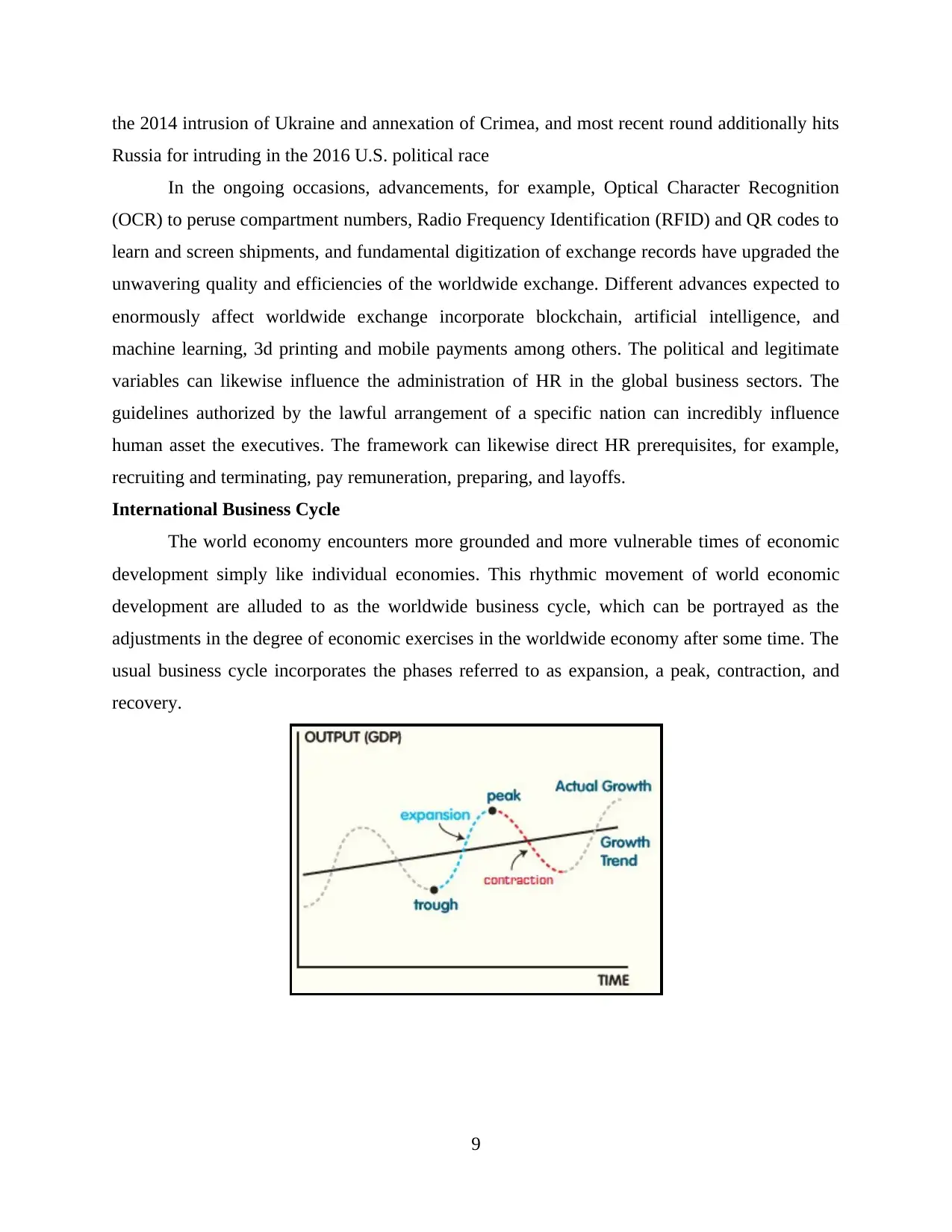
the 2014 intrusion of Ukraine and annexation of Crimea, and most recent round additionally hits
Russia for intruding in the 2016 U.S. political race
In the ongoing occasions, advancements, for example, Optical Character Recognition
(OCR) to peruse compartment numbers, Radio Frequency Identification (RFID) and QR codes to
learn and screen shipments, and fundamental digitization of exchange records have upgraded the
unwavering quality and efficiencies of the worldwide exchange. Different advances expected to
enormously affect worldwide exchange incorporate blockchain, artificial intelligence, and
machine learning, 3d printing and mobile payments among others. The political and legitimate
variables can likewise influence the administration of HR in the global business sectors. The
guidelines authorized by the lawful arrangement of a specific nation can incredibly influence
human asset the executives. The framework can likewise direct HR prerequisites, for example,
recruiting and terminating, pay remuneration, preparing, and layoffs.
International Business Cycle
The world economy encounters more grounded and more vulnerable times of economic
development simply like individual economies. This rhythmic movement of world economic
development are alluded to as the worldwide business cycle, which can be portrayed as the
adjustments in the degree of economic exercises in the worldwide economy after some time. The
usual business cycle incorporates the phases referred to as expansion, a peak, contraction, and
recovery.
9
Russia for intruding in the 2016 U.S. political race
In the ongoing occasions, advancements, for example, Optical Character Recognition
(OCR) to peruse compartment numbers, Radio Frequency Identification (RFID) and QR codes to
learn and screen shipments, and fundamental digitization of exchange records have upgraded the
unwavering quality and efficiencies of the worldwide exchange. Different advances expected to
enormously affect worldwide exchange incorporate blockchain, artificial intelligence, and
machine learning, 3d printing and mobile payments among others. The political and legitimate
variables can likewise influence the administration of HR in the global business sectors. The
guidelines authorized by the lawful arrangement of a specific nation can incredibly influence
human asset the executives. The framework can likewise direct HR prerequisites, for example,
recruiting and terminating, pay remuneration, preparing, and layoffs.
International Business Cycle
The world economy encounters more grounded and more vulnerable times of economic
development simply like individual economies. This rhythmic movement of world economic
development are alluded to as the worldwide business cycle, which can be portrayed as the
adjustments in the degree of economic exercises in the worldwide economy after some time. The
usual business cycle incorporates the phases referred to as expansion, a peak, contraction, and
recovery.
9
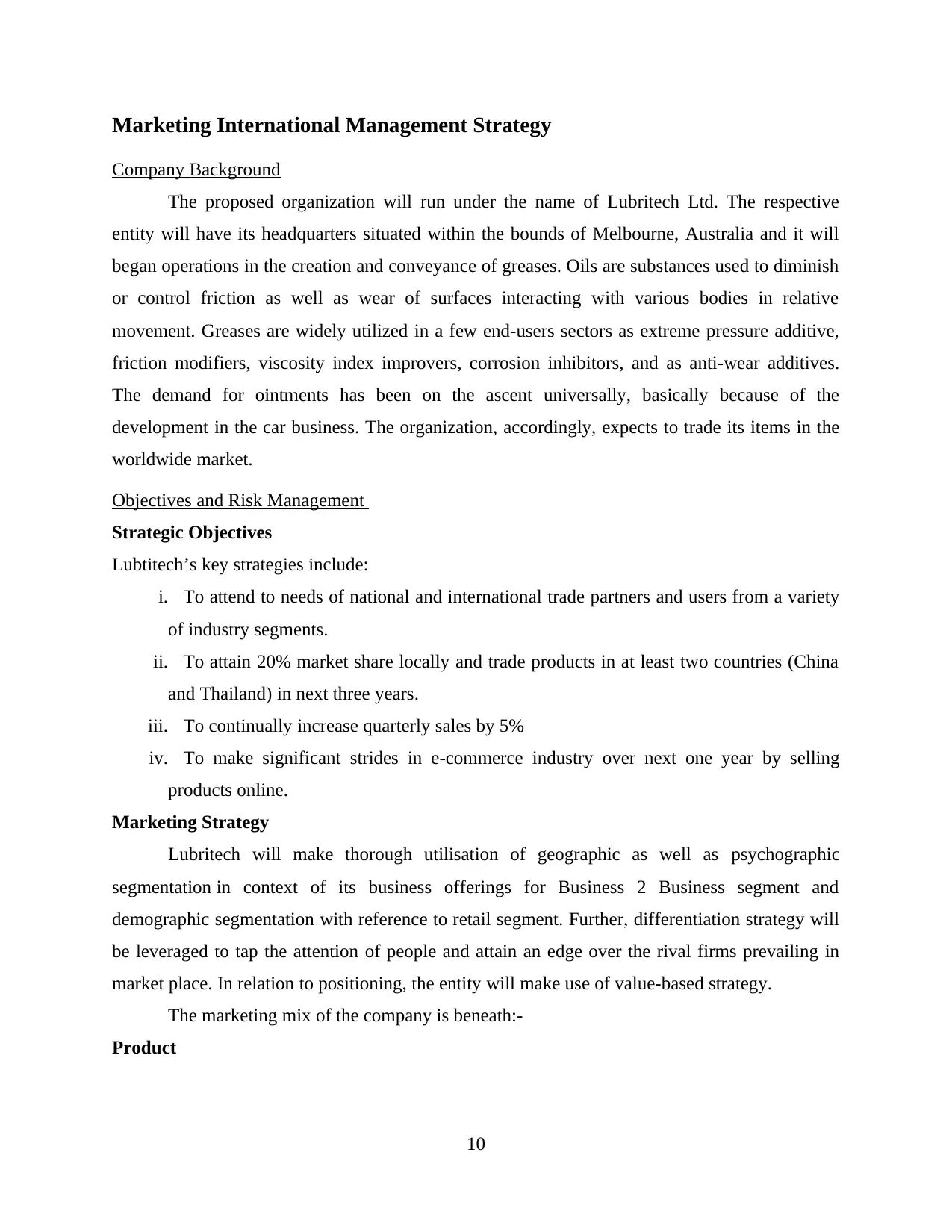
Marketing International Management Strategy
Company Background
The proposed organization will run under the name of Lubritech Ltd. The respective
entity will have its headquarters situated within the bounds of Melbourne, Australia and it will
began operations in the creation and conveyance of greases. Oils are substances used to diminish
or control friction as well as wear of surfaces interacting with various bodies in relative
movement. Greases are widely utilized in a few end-users sectors as extreme pressure additive,
friction modifiers, viscosity index improvers, corrosion inhibitors, and as anti-wear additives.
The demand for ointments has been on the ascent universally, basically because of the
development in the car business. The organization, accordingly, expects to trade its items in the
worldwide market.
Objectives and Risk Management
Strategic Objectives
Lubtitech’s key strategies include:
i. To attend to needs of national and international trade partners and users from a variety
of industry segments.
ii. To attain 20% market share locally and trade products in at least two countries (China
and Thailand) in next three years.
iii. To continually increase quarterly sales by 5%
iv. To make significant strides in e-commerce industry over next one year by selling
products online.
Marketing Strategy
Lubritech will make thorough utilisation of geographic as well as psychographic
segmentation in context of its business offerings for Business 2 Business segment and
demographic segmentation with reference to retail segment. Further, differentiation strategy will
be leveraged to tap the attention of people and attain an edge over the rival firms prevailing in
market place. In relation to positioning, the entity will make use of value-based strategy.
The marketing mix of the company is beneath:-
Product
10
Company Background
The proposed organization will run under the name of Lubritech Ltd. The respective
entity will have its headquarters situated within the bounds of Melbourne, Australia and it will
began operations in the creation and conveyance of greases. Oils are substances used to diminish
or control friction as well as wear of surfaces interacting with various bodies in relative
movement. Greases are widely utilized in a few end-users sectors as extreme pressure additive,
friction modifiers, viscosity index improvers, corrosion inhibitors, and as anti-wear additives.
The demand for ointments has been on the ascent universally, basically because of the
development in the car business. The organization, accordingly, expects to trade its items in the
worldwide market.
Objectives and Risk Management
Strategic Objectives
Lubtitech’s key strategies include:
i. To attend to needs of national and international trade partners and users from a variety
of industry segments.
ii. To attain 20% market share locally and trade products in at least two countries (China
and Thailand) in next three years.
iii. To continually increase quarterly sales by 5%
iv. To make significant strides in e-commerce industry over next one year by selling
products online.
Marketing Strategy
Lubritech will make thorough utilisation of geographic as well as psychographic
segmentation in context of its business offerings for Business 2 Business segment and
demographic segmentation with reference to retail segment. Further, differentiation strategy will
be leveraged to tap the attention of people and attain an edge over the rival firms prevailing in
market place. In relation to positioning, the entity will make use of value-based strategy.
The marketing mix of the company is beneath:-
Product
10
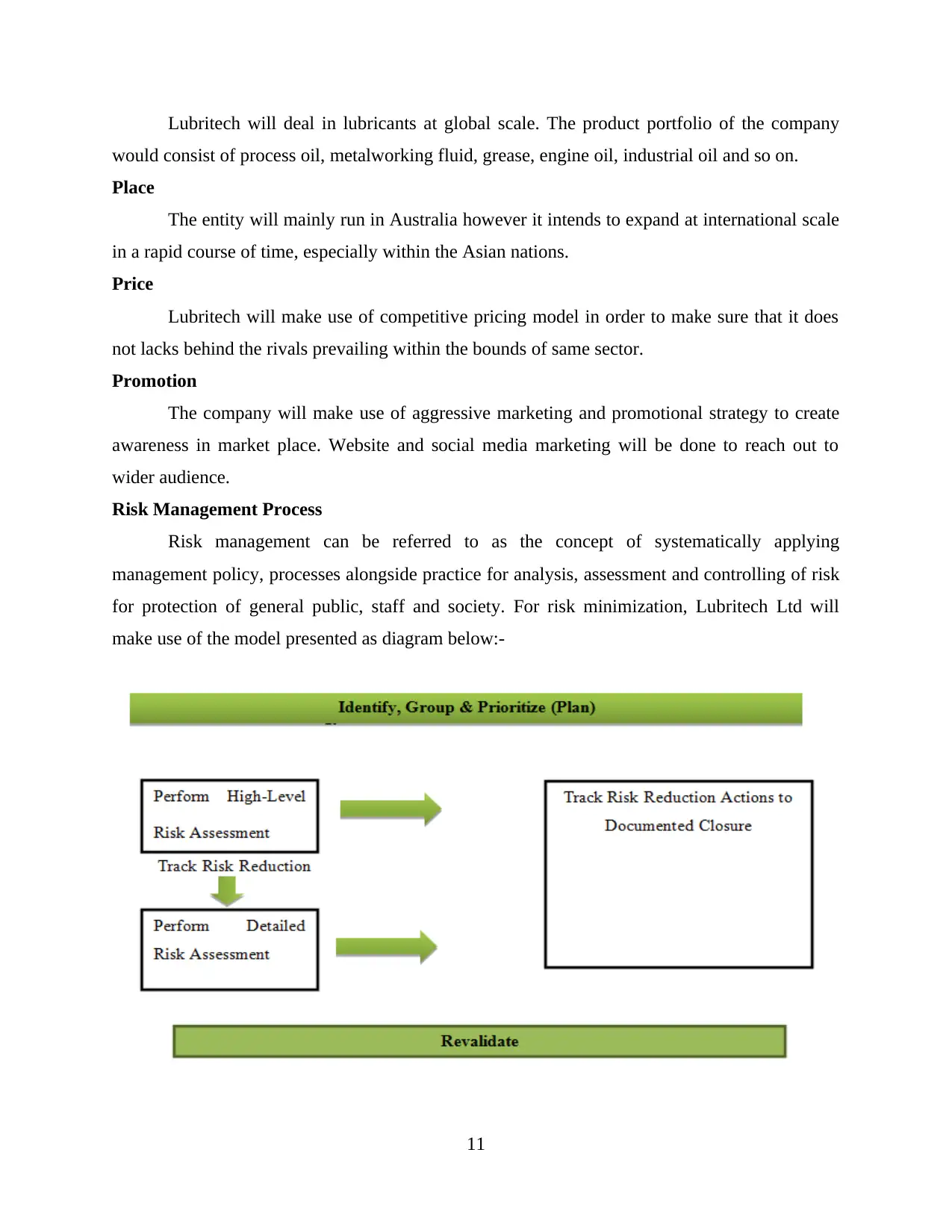
Lubritech will deal in lubricants at global scale. The product portfolio of the company
would consist of process oil, metalworking fluid, grease, engine oil, industrial oil and so on.
Place
The entity will mainly run in Australia however it intends to expand at international scale
in a rapid course of time, especially within the Asian nations.
Price
Lubritech will make use of competitive pricing model in order to make sure that it does
not lacks behind the rivals prevailing within the bounds of same sector.
Promotion
The company will make use of aggressive marketing and promotional strategy to create
awareness in market place. Website and social media marketing will be done to reach out to
wider audience.
Risk Management Process
Risk management can be referred to as the concept of systematically applying
management policy, processes alongside practice for analysis, assessment and controlling of risk
for protection of general public, staff and society. For risk minimization, Lubritech Ltd will
make use of the model presented as diagram below:-
11
would consist of process oil, metalworking fluid, grease, engine oil, industrial oil and so on.
Place
The entity will mainly run in Australia however it intends to expand at international scale
in a rapid course of time, especially within the Asian nations.
Price
Lubritech will make use of competitive pricing model in order to make sure that it does
not lacks behind the rivals prevailing within the bounds of same sector.
Promotion
The company will make use of aggressive marketing and promotional strategy to create
awareness in market place. Website and social media marketing will be done to reach out to
wider audience.
Risk Management Process
Risk management can be referred to as the concept of systematically applying
management policy, processes alongside practice for analysis, assessment and controlling of risk
for protection of general public, staff and society. For risk minimization, Lubritech Ltd will
make use of the model presented as diagram below:-
11
Paraphrase This Document
Need a fresh take? Get an instant paraphrase of this document with our AI Paraphraser
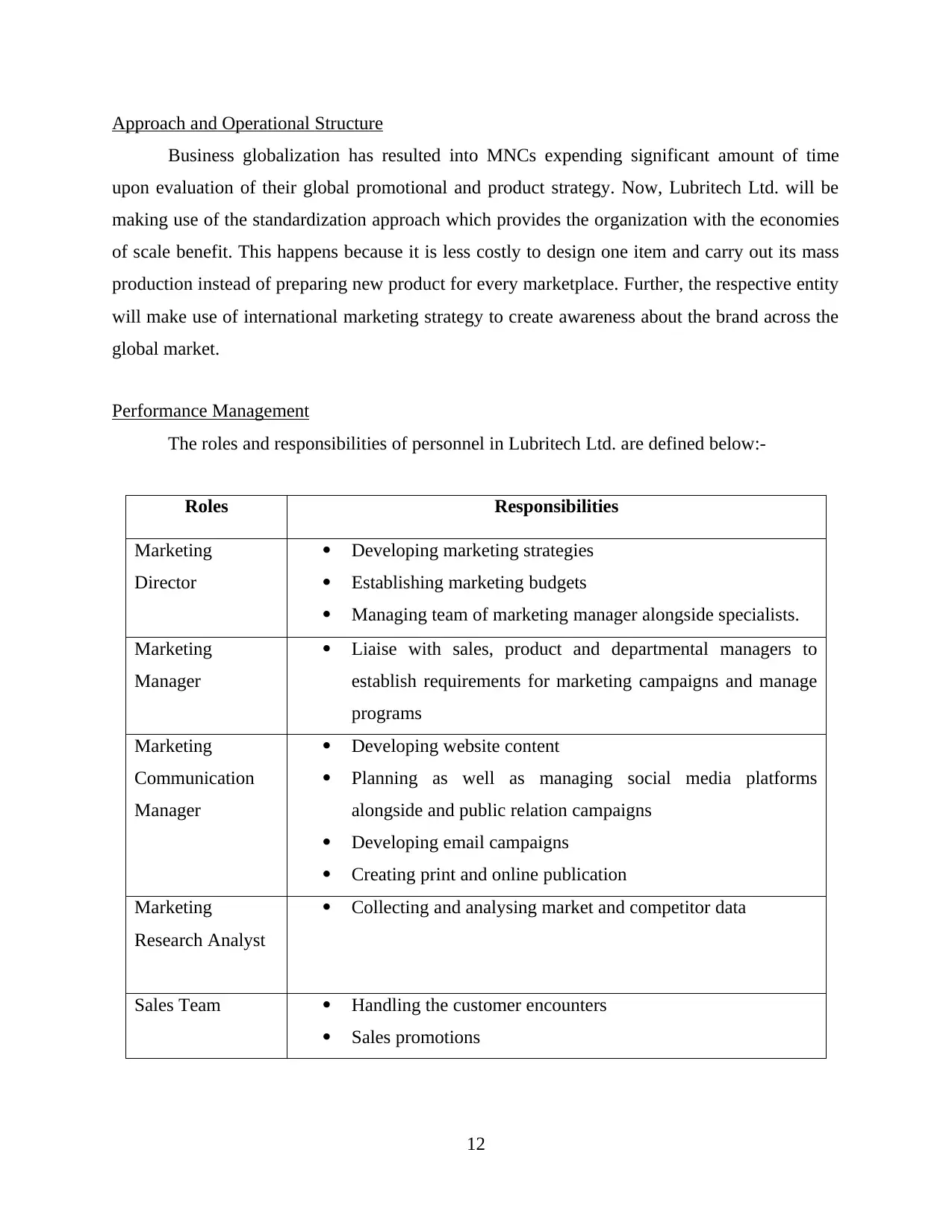
Approach and Operational Structure
Business globalization has resulted into MNCs expending significant amount of time
upon evaluation of their global promotional and product strategy. Now, Lubritech Ltd. will be
making use of the standardization approach which provides the organization with the economies
of scale benefit. This happens because it is less costly to design one item and carry out its mass
production instead of preparing new product for every marketplace. Further, the respective entity
will make use of international marketing strategy to create awareness about the brand across the
global market.
Performance Management
The roles and responsibilities of personnel in Lubritech Ltd. are defined below:-
Roles Responsibilities
Marketing
Director
Developing marketing strategies
Establishing marketing budgets
Managing team of marketing manager alongside specialists.
Marketing
Manager
Liaise with sales, product and departmental managers to
establish requirements for marketing campaigns and manage
programs
Marketing
Communication
Manager
Developing website content
Planning as well as managing social media platforms
alongside and public relation campaigns
Developing email campaigns
Creating print and online publication
Marketing
Research Analyst
Collecting and analysing market and competitor data
Sales Team Handling the customer encounters
Sales promotions
12
Business globalization has resulted into MNCs expending significant amount of time
upon evaluation of their global promotional and product strategy. Now, Lubritech Ltd. will be
making use of the standardization approach which provides the organization with the economies
of scale benefit. This happens because it is less costly to design one item and carry out its mass
production instead of preparing new product for every marketplace. Further, the respective entity
will make use of international marketing strategy to create awareness about the brand across the
global market.
Performance Management
The roles and responsibilities of personnel in Lubritech Ltd. are defined below:-
Roles Responsibilities
Marketing
Director
Developing marketing strategies
Establishing marketing budgets
Managing team of marketing manager alongside specialists.
Marketing
Manager
Liaise with sales, product and departmental managers to
establish requirements for marketing campaigns and manage
programs
Marketing
Communication
Manager
Developing website content
Planning as well as managing social media platforms
alongside and public relation campaigns
Developing email campaigns
Creating print and online publication
Marketing
Research Analyst
Collecting and analysing market and competitor data
Sales Team Handling the customer encounters
Sales promotions
12
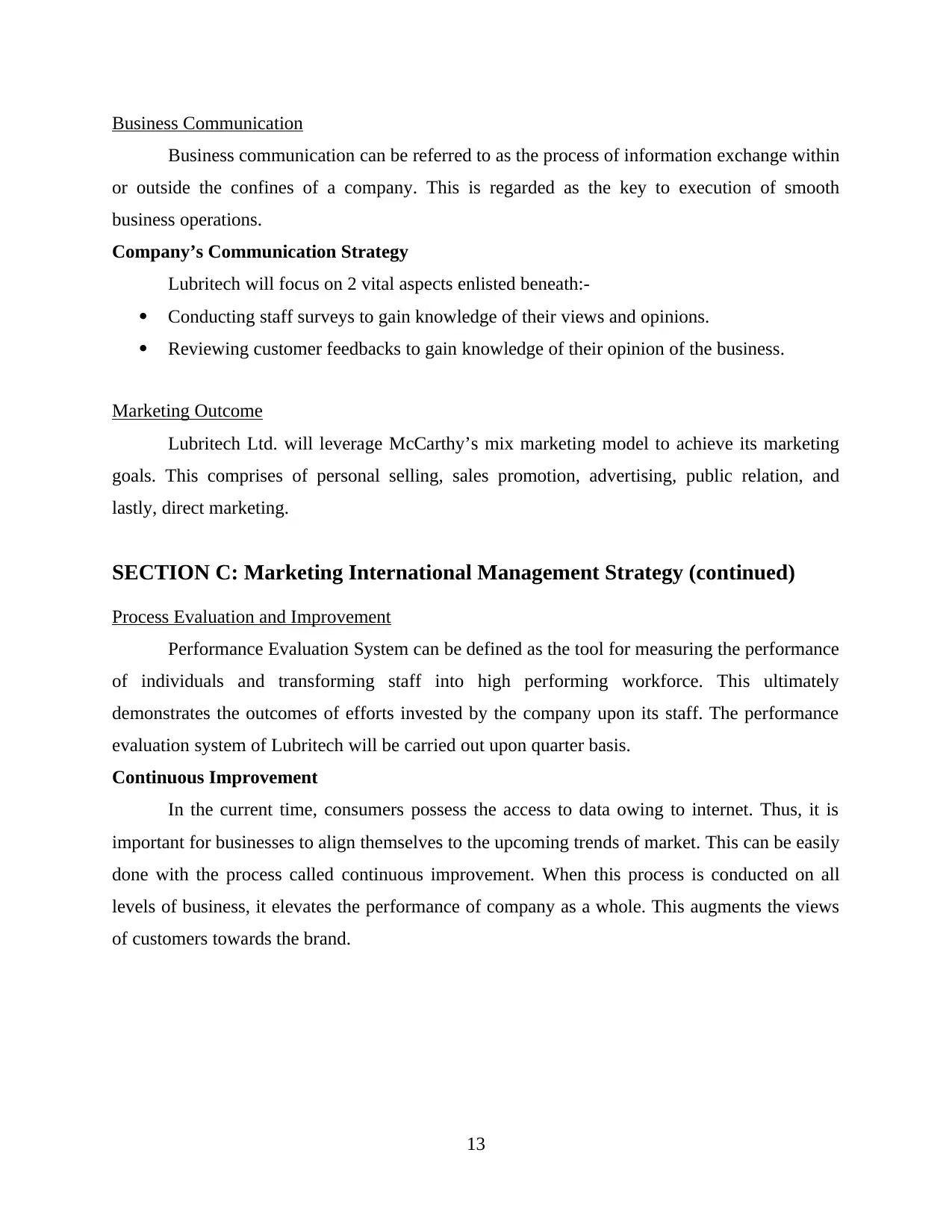
Business Communication
Business communication can be referred to as the process of information exchange within
or outside the confines of a company. This is regarded as the key to execution of smooth
business operations.
Company’s Communication Strategy
Lubritech will focus on 2 vital aspects enlisted beneath:-
Conducting staff surveys to gain knowledge of their views and opinions.
Reviewing customer feedbacks to gain knowledge of their opinion of the business.
Marketing Outcome
Lubritech Ltd. will leverage McCarthy’s mix marketing model to achieve its marketing
goals. This comprises of personal selling, sales promotion, advertising, public relation, and
lastly, direct marketing.
SECTION C: Marketing International Management Strategy (continued)
Process Evaluation and Improvement
Performance Evaluation System can be defined as the tool for measuring the performance
of individuals and transforming staff into high performing workforce. This ultimately
demonstrates the outcomes of efforts invested by the company upon its staff. The performance
evaluation system of Lubritech will be carried out upon quarter basis.
Continuous Improvement
In the current time, consumers possess the access to data owing to internet. Thus, it is
important for businesses to align themselves to the upcoming trends of market. This can be easily
done with the process called continuous improvement. When this process is conducted on all
levels of business, it elevates the performance of company as a whole. This augments the views
of customers towards the brand.
13
Business communication can be referred to as the process of information exchange within
or outside the confines of a company. This is regarded as the key to execution of smooth
business operations.
Company’s Communication Strategy
Lubritech will focus on 2 vital aspects enlisted beneath:-
Conducting staff surveys to gain knowledge of their views and opinions.
Reviewing customer feedbacks to gain knowledge of their opinion of the business.
Marketing Outcome
Lubritech Ltd. will leverage McCarthy’s mix marketing model to achieve its marketing
goals. This comprises of personal selling, sales promotion, advertising, public relation, and
lastly, direct marketing.
SECTION C: Marketing International Management Strategy (continued)
Process Evaluation and Improvement
Performance Evaluation System can be defined as the tool for measuring the performance
of individuals and transforming staff into high performing workforce. This ultimately
demonstrates the outcomes of efforts invested by the company upon its staff. The performance
evaluation system of Lubritech will be carried out upon quarter basis.
Continuous Improvement
In the current time, consumers possess the access to data owing to internet. Thus, it is
important for businesses to align themselves to the upcoming trends of market. This can be easily
done with the process called continuous improvement. When this process is conducted on all
levels of business, it elevates the performance of company as a whole. This augments the views
of customers towards the brand.
13
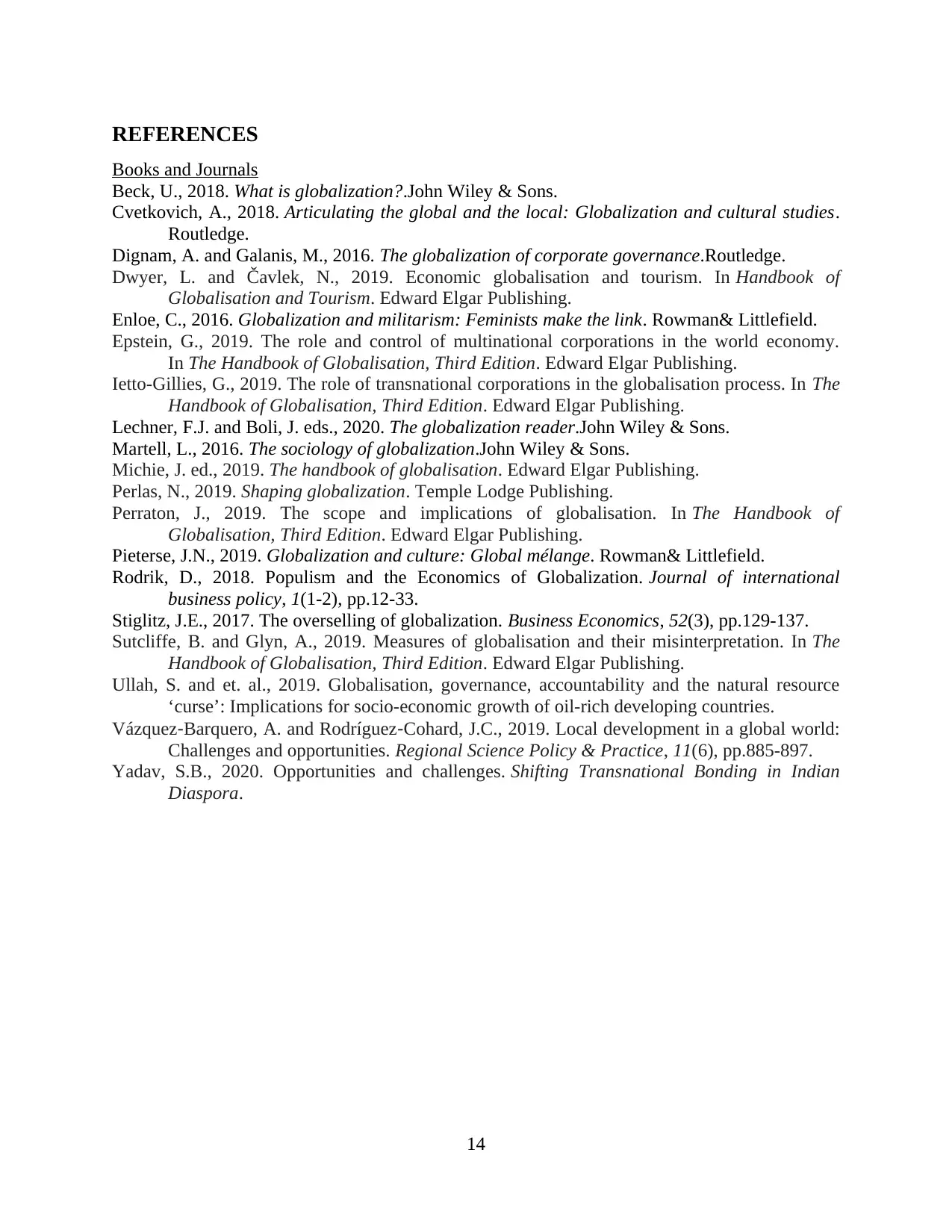
REFERENCES
Books and Journals
Beck, U., 2018. What is globalization?.John Wiley & Sons.
Cvetkovich, A., 2018. Articulating the global and the local: Globalization and cultural studies.
Routledge.
Dignam, A. and Galanis, M., 2016. The globalization of corporate governance.Routledge.
Dwyer, L. and Čavlek, N., 2019. Economic globalisation and tourism. In Handbook of
Globalisation and Tourism. Edward Elgar Publishing.
Enloe, C., 2016. Globalization and militarism: Feminists make the link. Rowman& Littlefield.
Epstein, G., 2019. The role and control of multinational corporations in the world economy.
In The Handbook of Globalisation, Third Edition. Edward Elgar Publishing.
Ietto-Gillies, G., 2019. The role of transnational corporations in the globalisation process. In The
Handbook of Globalisation, Third Edition. Edward Elgar Publishing.
Lechner, F.J. and Boli, J. eds., 2020. The globalization reader.John Wiley & Sons.
Martell, L., 2016. The sociology of globalization.John Wiley & Sons.
Michie, J. ed., 2019. The handbook of globalisation. Edward Elgar Publishing.
Perlas, N., 2019. Shaping globalization. Temple Lodge Publishing.
Perraton, J., 2019. The scope and implications of globalisation. In The Handbook of
Globalisation, Third Edition. Edward Elgar Publishing.
Pieterse, J.N., 2019. Globalization and culture: Global mélange. Rowman& Littlefield.
Rodrik, D., 2018. Populism and the Economics of Globalization. Journal of international
business policy, 1(1-2), pp.12-33.
Stiglitz, J.E., 2017. The overselling of globalization. Business Economics, 52(3), pp.129-137.
Sutcliffe, B. and Glyn, A., 2019. Measures of globalisation and their misinterpretation. In The
Handbook of Globalisation, Third Edition. Edward Elgar Publishing.
Ullah, S. and et. al., 2019. Globalisation, governance, accountability and the natural resource
‘curse’: Implications for socio-economic growth of oil-rich developing countries.
Vázquez‐Barquero, A. and Rodríguez‐Cohard, J.C., 2019. Local development in a global world:
Challenges and opportunities. Regional Science Policy & Practice, 11(6), pp.885-897.
Yadav, S.B., 2020. Opportunities and challenges. Shifting Transnational Bonding in Indian
Diaspora.
14
Books and Journals
Beck, U., 2018. What is globalization?.John Wiley & Sons.
Cvetkovich, A., 2018. Articulating the global and the local: Globalization and cultural studies.
Routledge.
Dignam, A. and Galanis, M., 2016. The globalization of corporate governance.Routledge.
Dwyer, L. and Čavlek, N., 2019. Economic globalisation and tourism. In Handbook of
Globalisation and Tourism. Edward Elgar Publishing.
Enloe, C., 2016. Globalization and militarism: Feminists make the link. Rowman& Littlefield.
Epstein, G., 2019. The role and control of multinational corporations in the world economy.
In The Handbook of Globalisation, Third Edition. Edward Elgar Publishing.
Ietto-Gillies, G., 2019. The role of transnational corporations in the globalisation process. In The
Handbook of Globalisation, Third Edition. Edward Elgar Publishing.
Lechner, F.J. and Boli, J. eds., 2020. The globalization reader.John Wiley & Sons.
Martell, L., 2016. The sociology of globalization.John Wiley & Sons.
Michie, J. ed., 2019. The handbook of globalisation. Edward Elgar Publishing.
Perlas, N., 2019. Shaping globalization. Temple Lodge Publishing.
Perraton, J., 2019. The scope and implications of globalisation. In The Handbook of
Globalisation, Third Edition. Edward Elgar Publishing.
Pieterse, J.N., 2019. Globalization and culture: Global mélange. Rowman& Littlefield.
Rodrik, D., 2018. Populism and the Economics of Globalization. Journal of international
business policy, 1(1-2), pp.12-33.
Stiglitz, J.E., 2017. The overselling of globalization. Business Economics, 52(3), pp.129-137.
Sutcliffe, B. and Glyn, A., 2019. Measures of globalisation and their misinterpretation. In The
Handbook of Globalisation, Third Edition. Edward Elgar Publishing.
Ullah, S. and et. al., 2019. Globalisation, governance, accountability and the natural resource
‘curse’: Implications for socio-economic growth of oil-rich developing countries.
Vázquez‐Barquero, A. and Rodríguez‐Cohard, J.C., 2019. Local development in a global world:
Challenges and opportunities. Regional Science Policy & Practice, 11(6), pp.885-897.
Yadav, S.B., 2020. Opportunities and challenges. Shifting Transnational Bonding in Indian
Diaspora.
14
1 out of 16
Related Documents
Your All-in-One AI-Powered Toolkit for Academic Success.
+13062052269
info@desklib.com
Available 24*7 on WhatsApp / Email
![[object Object]](/_next/static/media/star-bottom.7253800d.svg)
Unlock your academic potential
© 2024 | Zucol Services PVT LTD | All rights reserved.





